There are dozens of chicken breeds, with more being created constantly!
These days, it’s possible to have a rainbow of chickens, all with unique colors, feather patterns, comb shapes, and other striking physical traits.
But even the more monochrome chickens are just as beautiful!
Here are 15 fabulous black and white chicken breeds you’ll love to have in your flock.
Table of Contents
ToggleBarred Plymouth Rock
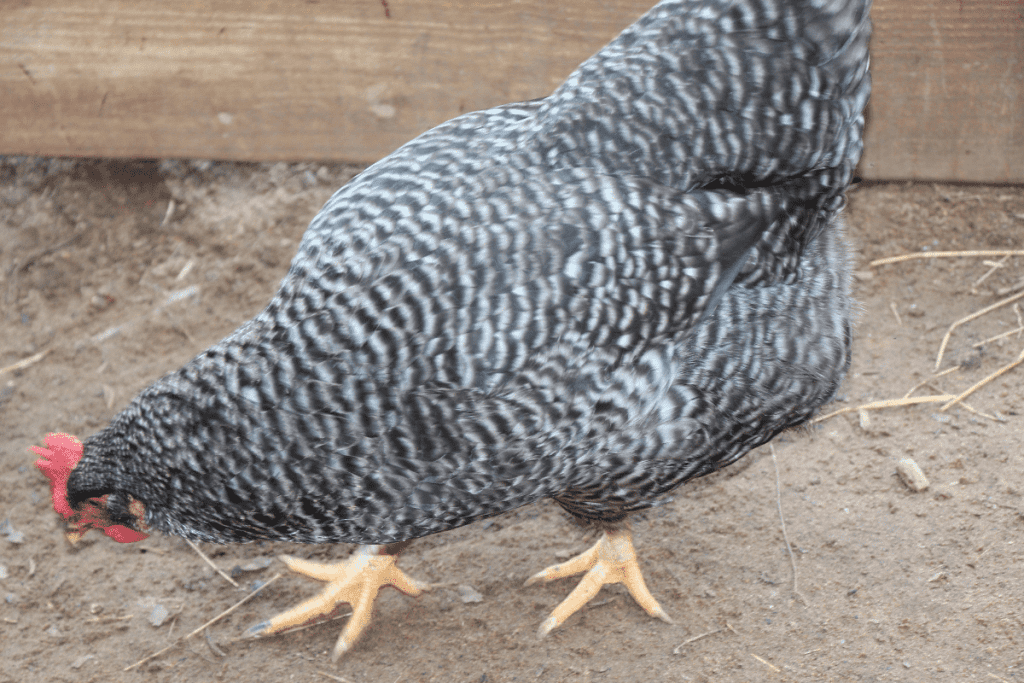
This list wouldn’t be complete without the wildly popular barred Plymouth rock breed!
These chickens have been around since the 1800s, and they’ve been helpful for both their meat and eggs.
Check out these other benefits of keeping chickens.
These hardy chickens have a unique “barred” or striped pattern which makes them stand out amongst any flock.
There are many reasons why the Plymouth barred rock breed has become so wildly popular!
In addition to their dual purpose as egg-laying and meat birds, barred rocks are also an excellent pet for hobby farmers.
Their docile, curious, and mild-mannered temperament makes them a joy to observe, handle, and bond with.
Although these well-loved birds now exist in various colors, the original monochrome coloration is the most popular.
It has become sort of an unofficial representative of the breed.
They’ve also been crossbred with various other breeds over the years, as they breed very quickly in captivity, are prolific egg layers, and are pretty broody.
White Sussex

The Sussex breed has eight unique colors, but the white variation (technically black and white) is undoubtedly one of the most handsome!
This British breed dates back to the 1800s and was developed in the historic Sussex region.
It’s known for being one of the oldest chicken breeds globally!
These iconic birds have long been raised for both meat and eggs, and in more recent years, they’ve also become popular as pets.
The white Sussex, in particular, has beautiful black and white markings, with the majority of their bodies being white and accented by the black tail and neck feathers.
Their appearance has even made them somewhat popular show chickens.
White Sussex chickens do well in a wide range of climates, as they are very hardy and adaptable, excellent foragers.
Thanks to their docile, curious, and approachable personalities, they also make great pets.
Further reading: Are Sussex chickens aggressive or friendly?
Ancona
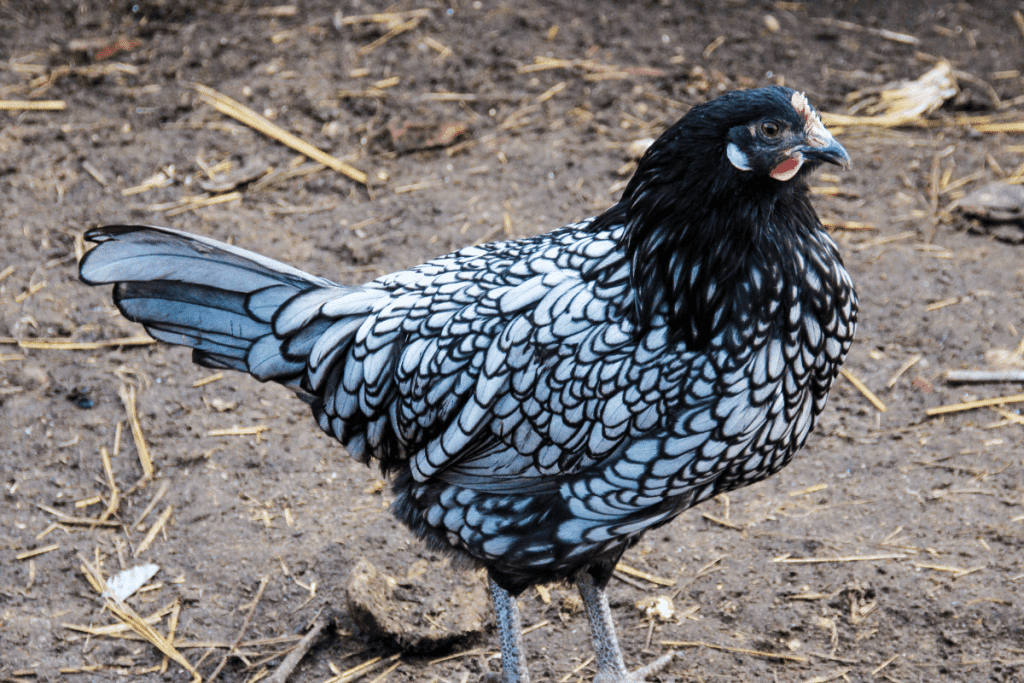
Named after the Italian capital of the Marche region, Ancona, this breed has long been popular in Europe since the 1800s.
After it became a successful breed in Italy, it quickly spread to the UK and was eventually exported to the US in the latter part of the 19th century.
Its most notable trait is its mottled black and white plumage, but it’s also an exceptional egg-laying breed.
The Ancona is hardy, lean, and healthy as a Mediterranean breed.
Though Ancona hens aren’t particularly broody, they are exceptional layers, and they begin laying large white eggs from a reasonably young age.
In addition to the typical breed, a smaller bantam variety also exists.
Its coloration gives its plumage a speckled appearance.
The Ancona chicken’s comb is usually the typical single shape, but larger, more irregular rose combs are also common.
Related reading: Are Ancona Chickens Broody?
Silver-Laced Wyandotte
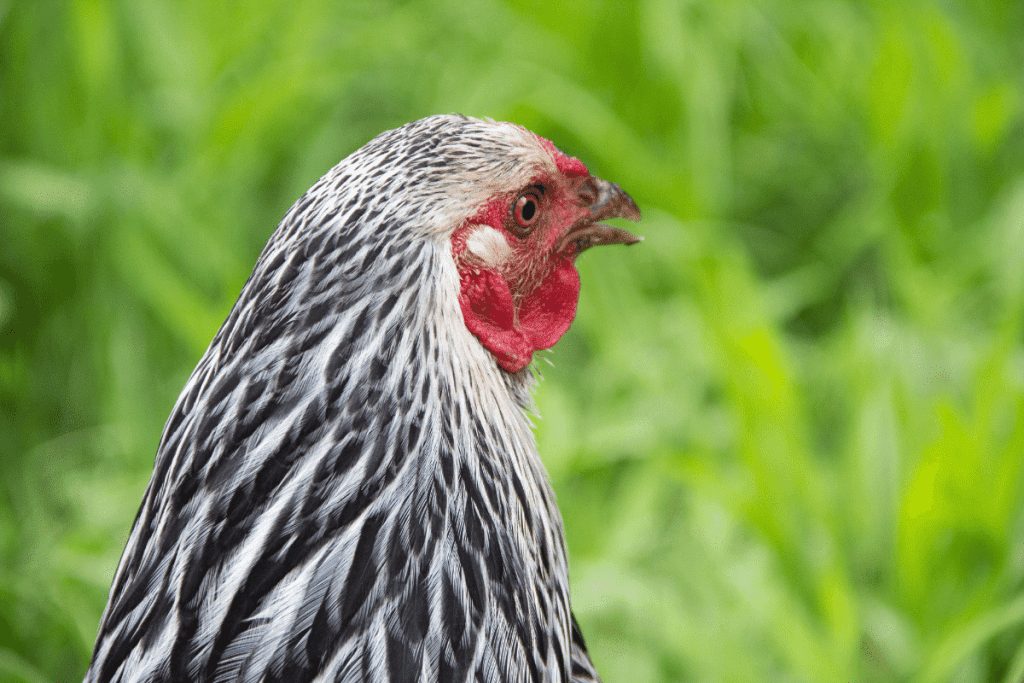
The Wyandotte is another well-known breed with a wide range of potential color patterns–nine of them!
Originally named the American Sebright, the Wyandotte was later renamed for the Wyandot (also sometimes spelled Wendat) Iroquoian indigenous people.
It was created in the US by four breeders in the late 1800s.
These large, dual-purpose chickens are useful for both their meat and eggs.
The Wyandotte is also popular as a pet chicken!
The silver-laced Wyandotte, in particular, has beautifully ornate black and white body plumage with a uniquely laced pattern.
This gorgeous color variety was also the first type to be officially recognized on a large scale.
Also, thanks to its unique coloration and patterning, it’s become a popular show bird.
Though it looks pretty fancy and rare, the Wyandotte is an accessible, inexpensive, all-around excellent breed.
Its mild-mannered temperament also makes it an excellent pet for beginner hobby farmers looking for a chicken with a truly unique look.
Related: Wyandotte chicken growth rate
Scots Grey
This dual-purpose breed somewhat closely resembles the barred Plymouth rock mentioned above, but the two are distinct chicken breeds!
As its name suggests, it was initially developed in Scotland, both for its eggs and its meat.
Other common names for the breed include the Scotch Grey and the Shepherd’s Plaid due to its barred, sort of tartan or plaid-looking plumage.
The Scots Grey has existed for over 200 years!
It’s a reasonably lightweight breed, but its white eggs are pretty significant. Hens aren’t very broody, making egg collection a breeze.
As with many breeds, there is also a smaller bantam variety that shares all the larger, standard breed’s traits.
These beautiful birds love to forage, and they are hardy and tolerate a wide range of temperatures.
They do exceptionally well in groups due to their social, curious nature.
Mottled Java
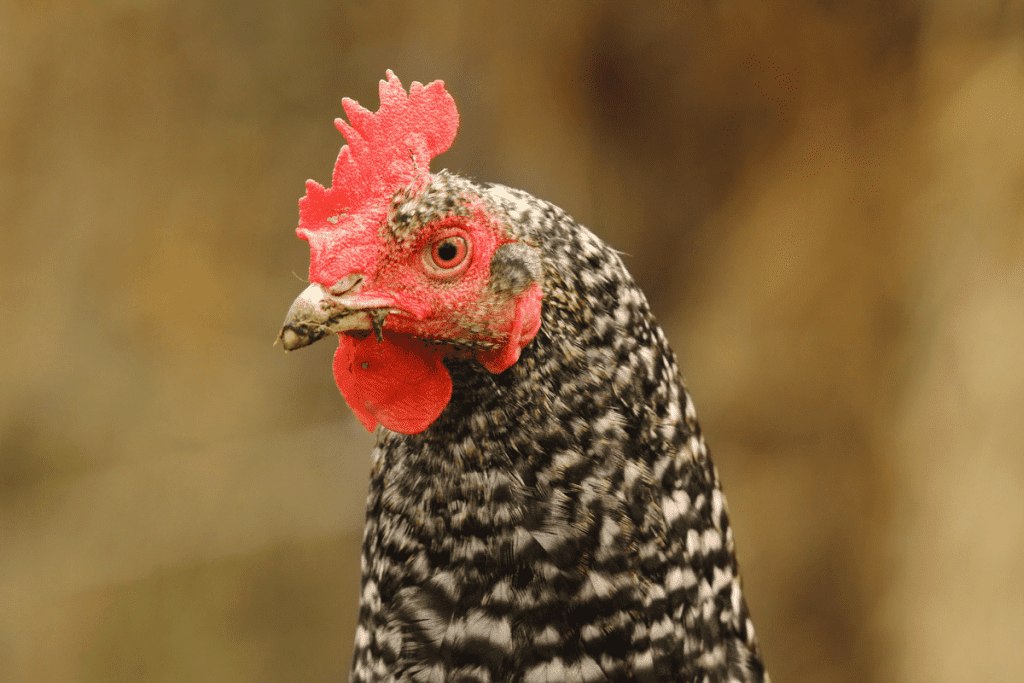
The Java chicken is an old breed originating in the United States, but its true roots are rumored to be closer to Asia.
These large birds exist in three different colors, but the mottled variety is the most visually striking.
Notably, the Java is a dual-purpose chicken, like many others on this list, so it’s useful for both its meat and eggs.
However, these beautiful, active birds grow reasonably slowly.
As a larger breed, the mottled Java is particularly hardy in cold and warm weather.
It’s also a strong and independent forager.
Their combs are typically uniformly single in shape.
Thanks to its rich history, the Java has been used as a sort of foundational breed in creating several popular modern breeds, such as the Jersey Giant and Plymouth Rock.
Unfortunately, over the years, the breed has become quite rare.
Although conservation efforts have helped preserve the Java chicken, their numbers are dwindling.
Hopefully, the breed will be restored to its former glory in the future.
Egyptian Fayoumi

As this breed’s name implies, the Egyptian Fayoumi was developed in the Fayoum region of Egypt.
These lean, lightweight birds exist in two primary color varieties, the silver- and gold-penciled.
Their plumage is truly stunning, with more white feathers around the head and neck gradually fading into darker grey and black feathers around the body, legs, and tail.
This breed is believed to be one of the oldest in existence, but its history is unclear.
It didn’t become popular in Europe or the US until the 20th century, but it is a well-loved, if somewhat niche, breed today.
There is also a smaller bantam variety.
The Egyptian Fayoumi is hardy and an active, healthy forager despite its lean build.
Its eggs are small, but it produces many of them and is not incredibly broody.
They grow and mature quickly and are best suited to areas with a warm or hot climate, as they don’t have much fat to keep them warm in cold weather.
Thanks to their hardiness and increased resistance to illnesses and infections, they’ve been crossbred with various American breeds.
More reading: Are Egyptian Fayoumi Roosters Aggressive?
Minorca
The Minorca is a Spanish breed with a rich and extensive history.
The breed originated from indigenous Menorcan birds in the UK in the late 1700s.
Over time, it became very popular as an egg-laying breed, eventually making it to Germany and later the US.
Typical Minorcas have entirely glossy black bodies; a coloration contrasted nicely by the white markings around their cheeks.
These markings are most prominent in males.
The single comb is the breed’s typical comb shape, but rose combs are also common.
Minorcas are medium-sized chickens and strong layers, and due to their shiny, black feathers, they’ve become popular backyard chickens and show birds.
Sadly, the Minorca is endangered on its home island of Menorca, but conservation efforts have been initiated in recent years to better preserve the breed.
Pita Pinta Asturiana/Asturian Painted
Another notable monochrome Spanish breed is the Pita Pinta Asturiana, also commonly known simply as the Asturian Painted for its beautiful mottled, splotchy plumage.
It’s native to the Asturias region in northwestern Spain and valuable for its meat and eggs.
Its name is also derived from the Asturian language; “pita” translates to “hen,” and “pinta” means either “painted” or “mottled.”
These medium-sized, relatively lean birds typically have light-colored, single-shaped combs.
There are four primary colors, but the Pinta Negra (mottled black) variety is the most well-known and common.
Asturian-painted chickens are hardy and strong, regular layers of medium-sized, cream-colored eggs.
Norfolk Grey
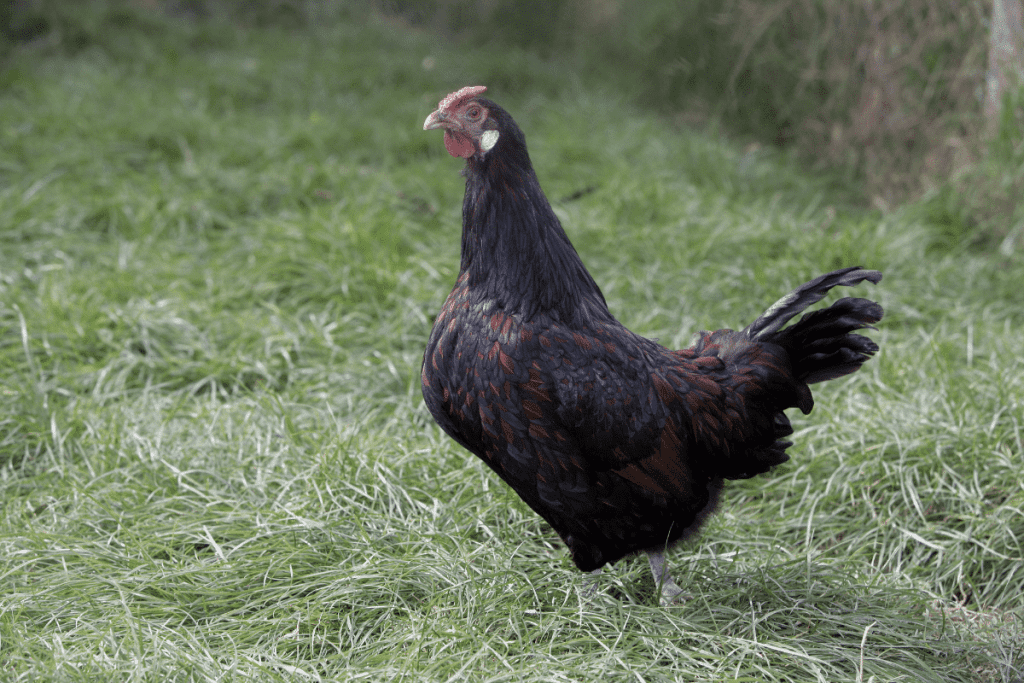
The Norfolk Grey is a useful multipurpose breed with high-quality meat and eggs.
In more recent years, it’s also become a popular pet and show bird.
This hardy breed is a bit more recent than many others on this list, originating in Norwich, Norfolk, England, in the early 20th century.
Its original name was the Black Maria.
Today, it’s a rare breed, but conservation efforts have helped keep the birds’ numbers up.
It nearly died out completely in the 1970s!
Fortunately, the entire breed was saved thanks to a private breeder’s flock of just four birds.
Norfolk Grey chickens are heavy-bodied, hardy birds and great layers.
Though they grow slowly, they’re also very useful for meat production.
They’re strong foragers and docile birds, and they do well in a range of climates.
Their unique plumage and friendly nature make them an excellent choice both as pets for backyard coops and as show birds.
Delaware
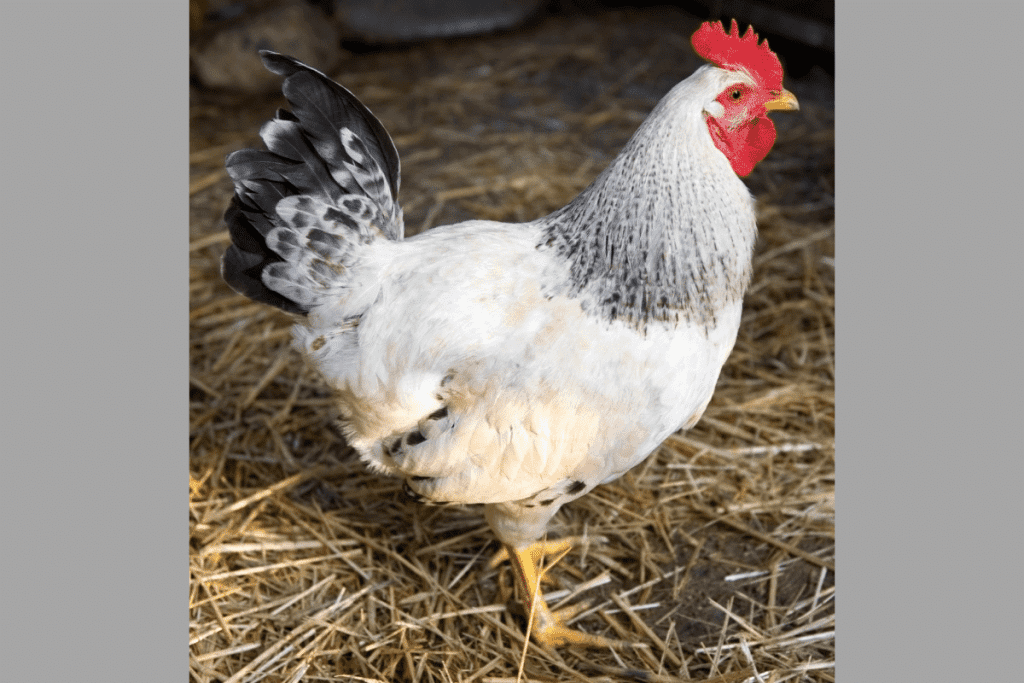
The Delaware chicken is a popular breed in just one color variation: white and black.
The majority of the bird’s body is white, with sporadic black barring around the neck and tail feathers.
Its comb is typically bright red and single in shape.
In addition to its standard variety, a lesser-known bantam version of the breed also exists.
As its name implies, this breed originated in Delaware in the early 1900s.
It’s a dual-purpose bird, useful for its meat and large, brown eggs.
Delaware chickens mature quickly and thrive in either a warm or cold climate.
The breed has also become somewhat popular as a show bird.
It was a prominent broiler for much of the early and mid-1900s, but today, its numbers are dwindling.
The Cornish-Rock quickly overtook it in popularity as a meat breed.
The American Livestock Breeds Conservancy classifies the breed as critically endangered.
Dominique
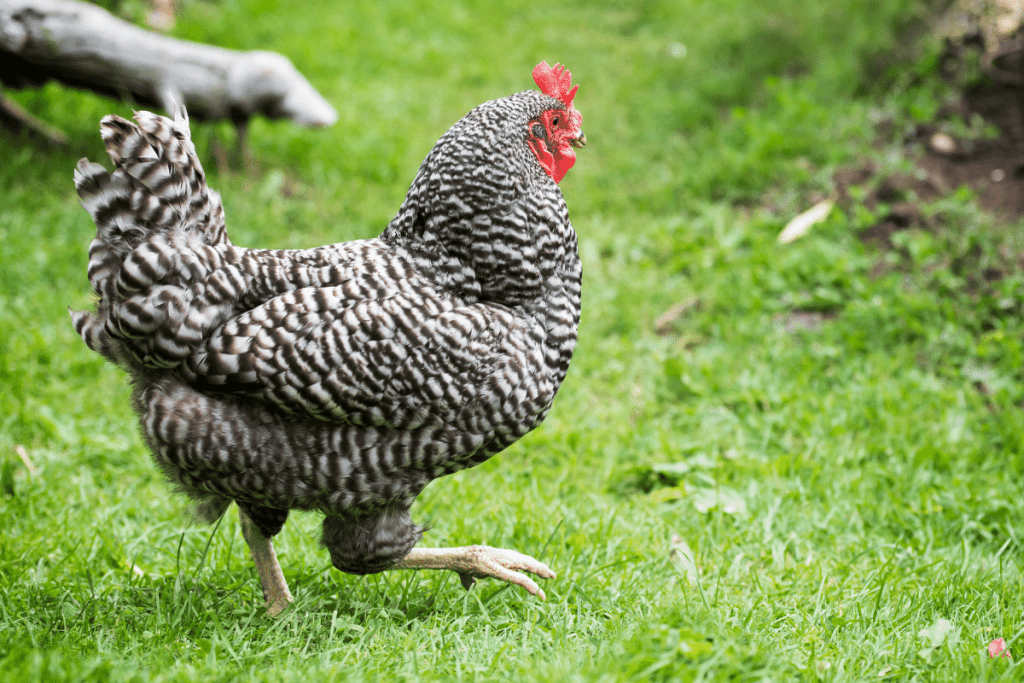
The Dominique chicken is another Plymouth Rock lookalike due to its large, round body and black and white barred plumage.
However, while the Plymouth rock typically has a single-shaped comb, larger and more irregularly-shaped rose combs are the standard of the Dominique breed.
Most historians believe the Dominique is the oldest American chicken breed, as it likely originated from birds colonists brought over from the UK.
The Dominique is a hardy dual-purpose breed, but it’s best known for its large, tasty brown eggs and is an excellent layer.
It’s had many common names over the years, such as the Dominicker, Pilgrim Fowl, and the Blue Spotted Hen.
Its only color is the barred black and white variety, also known as the “cuckoo” coloration.
The small rose comb and thick plumage make it great for colder climates.
Interestingly, the Dominique was endangered during part of the 20th century, but conservation efforts have revived the breed’s numbers.
White Crested Polish
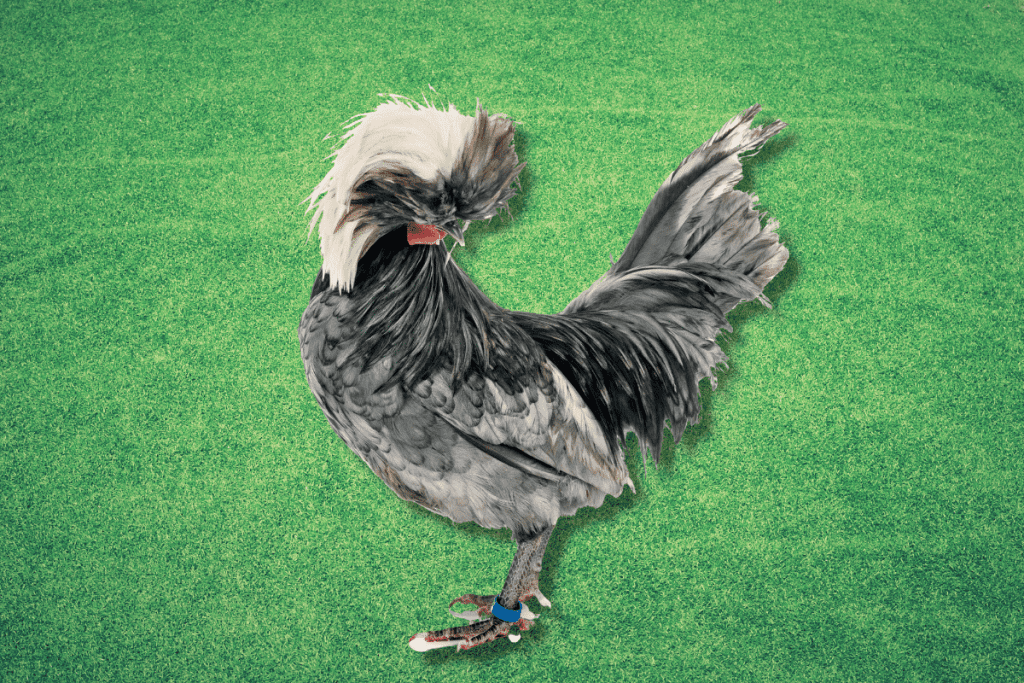
The Polish breed is striking, not only for the color of its plumage but also for the large, fluffy crest atop most birds’ heads.
While it is quite beautiful, this crest often limits the birds’ vision and sometimes affects their temperament, making them somewhat nervous birds.
The Polish chicken’s comb is a unique V-shape, which almost looks like little red horns at a distance!
There is also a smaller bantam version of the breed.
This European breed’s history is sort of obscured. Its name, in particular, is a mystery, as the breed likely has roots in Asia.
The most popular theory as to their origin is the Asian Mongols brought the birds’ ancestor breed to Europe, more specifically Poland, in the Middle Ages.
By the 1500s, it was well-known throughout Europe.
Further reading: Here’s what to know about ducks with afros.
Silver-Spangled Hamburg

The Hamburg breed exists in a whopping 11 color variations, but the silver-spangled is the one we’re particularly enamored with here.
Silver-spangled Hamburg chickens have a beautiful mottled coloration, with mostly white heads and necks and white tail feathers with black accents.
These small, lean birds have a slender build and typically have rose-shaped combs.
This breed’s history is also a mystery, though it almost definitely originated in Holland or Hamburg, Germany.
It’s an old breed with roots dating back to the 14th century.
Over the years, they have remained fairly popular as egg producers since the birds grow and mature quickly and lay eggs often.
However, their eggs are also fairly small due to the bird’s small size.
La Fleche
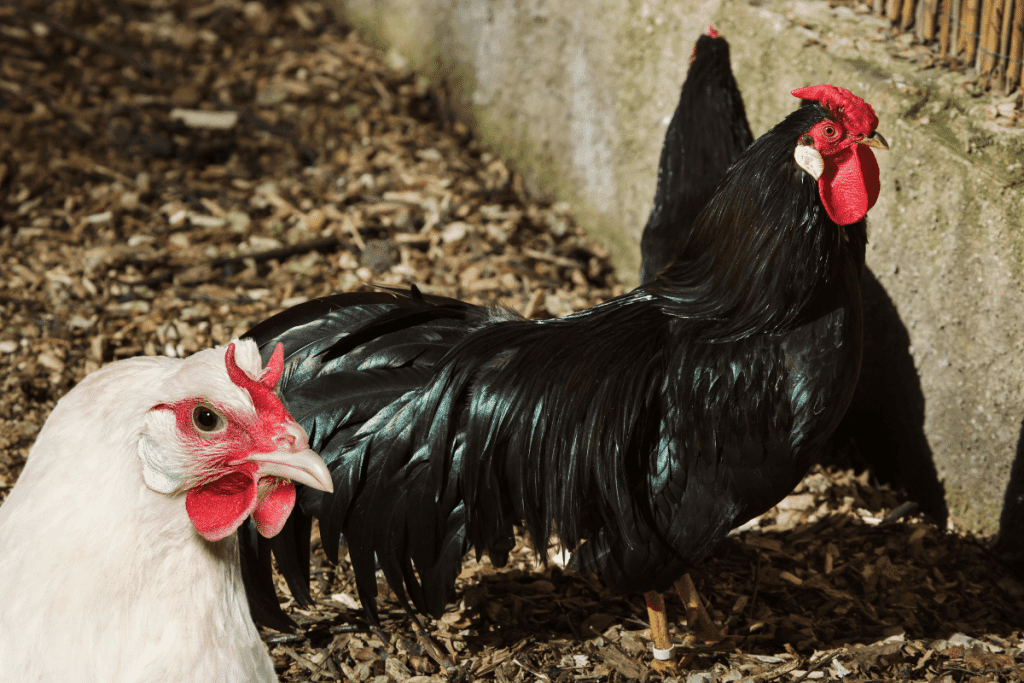
Finally, we cap off this list of black and white birds with the rather bizarre (and rare!) La Fleche breed.
Its main color variation is black with white markings around the face, earlobes, and wattles.
In addition to its glossy, solid greenish-black plumage, the breed is unique for its rare V-shaped comb.
This breed likely originated in the 1400s in France.
Originally, it was bred for its meat, but after World War II, its numbers declined as many other, hardier meat breeds became far more popular.
These medium-sized birds are very handsome pets and decent egg layers, but they don’t do so well in very hot or very cold climates.
How useful was this post?
Click on a star to rate it!
We are sorry that this post was not useful for you!
Let us improve this post!
Tell us how we can improve this post?
